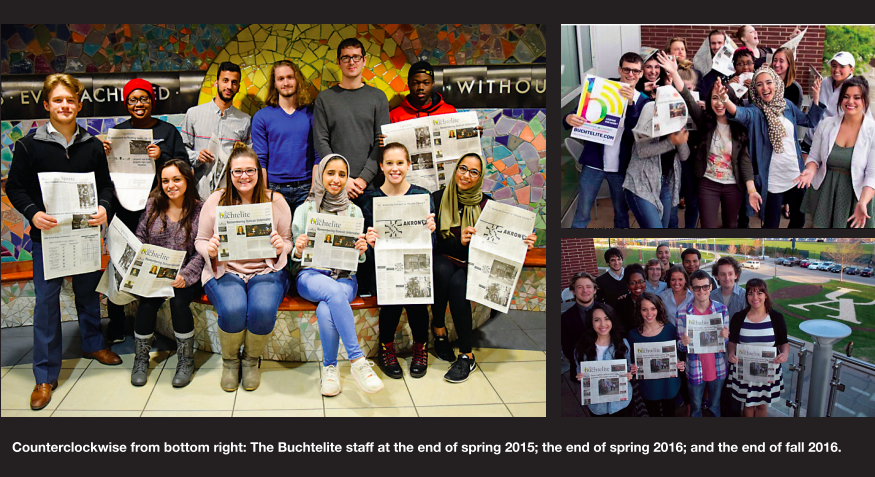“A knock-out. That’s what Ted Curtis, the University of Akron’s VP of capital planning and facility management, called the design of the new stadium. The design, which is about 95 percent finalized, will be built adjacent to Lee Jackson Field and the Athletic Field House.”
“
A knock-out.
That’s what Ted Curtis, the University of Akron’s VP of capital planning and facility management, called the design of the new stadium.
The design, which is about 95 percent finalized, will be built adjacent to Lee Jackson Field and the Athletic Field House. Although the drawings aren’t yet finalized, Curtis said they will not undergo much change from what the university already received from Cleveland-based HNTB Ohio Architecture Inc., the designer of the complex. HNTB is the company responsible for designing the state-of-the-art 75,000-seat San Francisco 49ers stadium.
The stadium design awaits the approval of the board of trustees at its Aug. 1 meeting.
The new stadium will seat between 25,000 to 30,000 people and includes 17 suites, 28 loges and 400 club seats.
Curtis said the building will be used for more than football functions. The stadium includes a 45,000 square foot, two-level area that will be used for classrooms. There will also be residence housing for students in the area of the new stadium, but details aren’t finalized. The university is also looking into using the venue for other events such as concerts or high school football games.
We still have a lot to work on, but certainly we would want to develop partnerships with the Akron community so that other events are held at the stadium, said director of athletics Mack Rhoades. Certainly we think high school football would be a great fit.
The university commissioned $2 million for the design of the stadium. The cost to build the stadium is estimated at $52.125 million.
The university hired the Welty Building Company, which is based in Akron, and the Hunt Construction Group, an Indianapolis firm, to build the stadium. The Hunt Construction Group has an impressive stadium-building resume, which includes Heinz Field in Pittsburgh, Ford Field in Detroit and Cleveland Browns Stadium.
If the board approves the design, UA will have to wait to construct the stadium. In a separate interview in mid-June, Curtis said it would take approximately six months to acquire the land on which the stadium will be built. In June, the board approved the use of eminent domain to acquire the remaining parcels of land UA needs.
A company has yet to be hired to raze the area. The City of Akron will take bids from area companies and Curtis expects the process to conclude by the end of the year.
After the board approves the new design, Curtis said it would take approximately six months to draft construction documents. Once UA acquires the remaining land, it will take about six to eight weeks to level the land, which predominantly consists of rental housing for students. Curtis said the university has budgeted $1.2 million to raze the land.
While the university is trying to acquire the land, it is also taking bids on site excavation and ordering the structural steel.
Once we acquire all the land, we would be ready to start moving dirt the next day, Curtis said. While we’re buying the land, we’ll be taking bids and finishing the drawings. It’s a sequential process.
It’s like a three-dimensional chess contest.
Other amenities
The university is also looking into a bridge connecting the athletic field house and the new stadium. The bridge would allow fans access to the stadium through the main concourse of the Student Recreation and Wellness Center and would also allow fans to utilize parking areas on Buchtel Avenue and Spicer Street. Curtis said if the project is under budget, the bridge would be a certainty.
The bridge would be similar to the one connecting the parking deck on Buchtel Ave. to the main campus. When UA built the parking deck, the project was under budget, paving the way for the bridge to be built.
Also, the stadium will be built to allow a roof to enclose the venue. Curtis said they looked into constructing a closed-roof stadium, but it would have cost an extra $60 million. In time, however, it could become a closed-roof venue.
Affecting attendance
The new stadium will also help cure some ills the athletic department has encountered, specifically with the football program. Last year, UA ranked 106th out of 119 Division I-A teams, averaging 16,137 fans per home contest. The attendance, however, was a significant increase from the 2005 season, when UA had the fourth worst attendance in Division I-A, averaging 10,893 per game.
However, the spike in attendance could be attributed to the Zips’ historic 2005 campaign in which they won their first Mid-American Conference championship and played in its first Division I-A bowl game. The number of season tickets rose to 4,100 in 2006, from just under 1,200 in 2005. Rhoades thinks that number can climb even higher.
One of the most prominent reasons for people not purchasing a season ticket or attending a game at the Rubber Bowl was the location and condition of the Rubber Bowl. We think having a state-of-the-art stadium will immediately help increase attendance.
The new stadium design offers premium seating such as suites, loges and club seats that the Rubber Bowl does not, which will also help raise attendance. He said he doesn’t anticipate a rise in ticket prices.
Rhoades said the goal of the new stadium design is to create a first-rate, on-campus facility.
Not in terms of the number of seats, he said, but in terms of the designs, the architecture and the amenities. We want it to rival the best in the country. When it’s all said and done, hopefully that is what we accomplish.
“
” #1.1361966:994285831.jpg:FootballStadium.jpg:The new on-campus football stadium designs will be released August 1 at UA’s board of trustees meeting.:File Photo”

